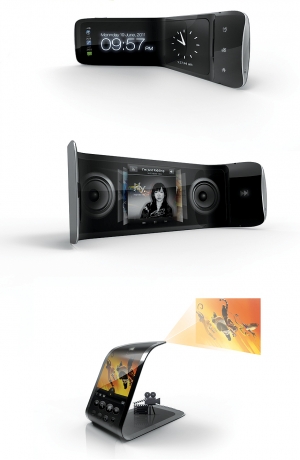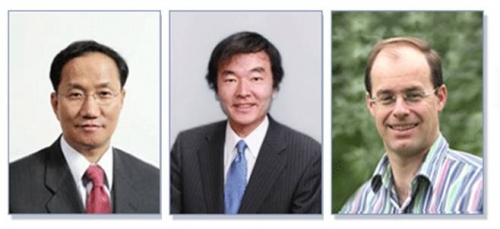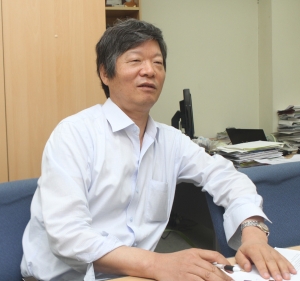
SEOUL, KOREA – A hundred years of Cathode-Ray Tube (CRT) cannot measure up to the recent ten years of the Display market’s rapid improvement. Liquid Crystal Displays (LCD) have dominated the global display market with over 80% share, replacing CRT with the benefits of less power consumption, smaller size, high definition and less electromagnetic wave.
However, LCDs still have shortcomings as they do not produce light themselves and need color filter to produce vivid tone. AMOLED (Active-Matrix Organic Light-Emitting Diode) changed the face of display technology as it emerged without necessitating backlights and color filters as they emit light and the three primary colors themselves, consequently making displays thinner and lighter. With Active-Matrix (AM) as contrast to passive-matrix, each pixel is controlled by one to four transistors that can make the screen perform faster, brighter, more colorful, and capable of being viewed at different angles.
On top of this, AMOLED display can considerably compensate for LCD’s shortcomings. While LCD has structural defects of narrow viewing angle and slow response speed, AMOLED can project clear images from every angle with no burn-ins and with fast response speed. It unveils almost natural hues while providing higher contrast range. Capable of consistent response speed at low temperature (-10℃) and high temperatures (40℃), AMOLED can be applied to car dashboards and displays.
Although Korea was not the first to initiate the AMOLED display development, it was the first country to succeed in mass production; several countries have failed in the past due to low profitability. Korean companies, Samsung and LG, dominating the global LCD market with around 50% share are now inclined to investing more on AM OLED, despite leading nations such as Taiwan, Japan and China accelerated investment on the display industry. Currently, Samsung holds 97% market share with its entire line-up of Galaxy using AMOLED.
Recently, Samsung Display succeeded in raising considerably AMOLED resolution using Fine Metal Mask (FMM) technology, a pixel patterning process. It expects to address AMOLED’s weakest areas unlike iPhone’s Retina Display. Stripe-RGB AMOLED resolution can now be raised to 350ppi, higher than iPhone 4S’s Retina Display (326ppi). LG Display has also emerged with a 55-inch white OLED TV panels at the International Consumer Electronics Show (CES) and at the Display Week hosted by Society for Information Display (SID). The product received similar reviews with Samsung’s RGB displays. The LG OLED TV was awarded “Best in the Show” by SID and “Best in the CES” by CNET, a tech media website.

AMOLED Display: Flexible and Transparent
AMOLED is the future of the display industry highlighting its flexibility and transparency. Samsung’s Galaxy Note 2, expected to be released next month, uses a 5.5 inch flexible display, a step forward to extending Samsung’s lead over its rivals. The product utilizes Unbreakable Plane (UBP) and plastic substrate that reduces thickness by 0.4T (0.4mm), consequently increasing battery capacity.
Just last month, LG Display was selected as a supervising organization for the transparent and flexible display project led by the Ministry of Knowledge Economy. The project aims to develop a 60-inch flexible and ultra-definition display with over 40 percent transparency by 2017, with the government investing over USD 50 million in the LG Display’s consortium that includes SMEs, universities and research centers.
Transparent and flexible displays enable people to hold business meetings using office windows without using separate video-conference devices. Passengers can see transportation information on bus stop windows while drivers can use car windows as an alternative navigation system. The future display technology with its transparent and flexible displays looks to replace books and paper and shift lifestyle paradigm in diverse areas including media, publication, architecture, fashion and interior.
Investment, R&D and Training Arms Display Sector
“To be the vanguard of the future display market, Investment, R&D and highly-skilled manpower play the most important roles in setting the tone of the game. Investments by both Samsung and LG reached USD 9 billion this year on top of the R&D allotment amounting to 5% of their total sales; more investment is expected to be made next year. In terms of training, Information Technology Research Center (ITRC) for AMOLED display is set to be put up to foster OLED professionals supported by the Korean Ministry of Knowledge Economy. As Samsung and LG Displays are both expanding to build industry-academic cooperation centers with universities, programs to train professionals are anticipated to continually increase in the future,” said Professor Jin Jang, President of the Korean Information Display Society (KIDS) and a director of Advanced Display Research Center (ADRC) in Kyung Hee University. ADRC also played a part in training display professionals, sending over 100 masters and PhDs to Samsung and LG.
The International Meeting on Information Display (IMID)
Latest issues and trends in display technologies will be seen at the upcoming International Meeting on Information Display at EXCO, Daegu from August 28 to 31, organized by the Korean Information Display Society (KIDS) and the Society for Information Display (SID). IMID is one of the three major display conferences alongside SID in the U.S., and the International Display Workshop (IDW) in Japan. The conference is a venue for academic, industry and business leaders to meet, publish results, and share knowledge in information display. It was formerly held in association with Korea Electronics Show but starting this year, it will be an exclusive meeting to provide an atmosphere conducive to academic and technology-based pursuit. The conference will consist of key addresses, technical sessions, tutorials, and awards, highlighting two key words in the display industry this year – ‘AMOLED’ and ‘flexible displays’.

Prominent professionals will be invited as speakers to discuss the latest trends and the prospect of future display technologies. One of the three keynote speakers, Soo-In Cho, president of Samsung Display will tackle display renaissance and the new OLED lifestyle. The Flexible AMOLED by Samsung’s 5-inch Galaxy Note 2, due to be released late this year will also be discussed. Two other noted authorities in the display sector are from Japan and the UK. Yasuhiro Koike, Professor from Keio University will present the status of photonics polymer used in face-to-face communication while Henning Sirringhaus, Professor from the University of Cambridge, is going to speak about low-temperature, solution-processible organic and oxide semiconductors for flexible electronics.

IMID boasts this year’s 432 meritorious write-ups, half of which came from Japan, Taiwan, China, U.S.A. and 15 other countries: 69 papers for OLED, 42 for 3D displays, 39 for flexible displays and 44 for nano materials and processes for displays. Among these papers, three types of awards will be given to groups from diverse countries by the Ministry of Education, Science and Technology (Republic of Korea), Merck and KIDS. The grand prize by MEST will be given to candidates from Yonsei University (Korea) on AMD (Active-Matrix Devices). Merck Grand Awards will go to groups from Koç University (Turkey) on 3D, University of Gothenburg (Sweden) on LCT, and KAIST (Korea) on OLED. Merck Young Scientists Awards will go to groups from Inha University (Korea) on AMD, KAIST (Korea) on Flexible. KIDS Awards will be given to GIST (Korea) on LED, Hongik University (Korea) on PDP, Fraunhofer Institute for Applied Polymer Research (Germany) on Nano and Technische Universität Dresden (Germany) on OLED.
Focusing on the four hottest issues in the display industry - OLED lighting technology, AMOLED display technology, 3D display technology and flexible display technology- tutorials will be conducted on the first day of the conference, all speakers coming from different organizations worldwide including Novaled, Holst Center, Organic Lighting Technologies LLC, Universal Display Corporation, Nouvoyance and Kyushu University.
With Korean display companies – Samsung and LG – dominating the global display market, many presentations from the industry leaders are bound to attract great attention from the participants. This year, the IT Convergence EXPO Korea 2012 (ITCE) and International LED & Display Expo (LED+) will be held from August 29 to 31 at the same venue with the conference to give participants an extraordinary experience of latest trends and the diverse technological features of the display industry.


